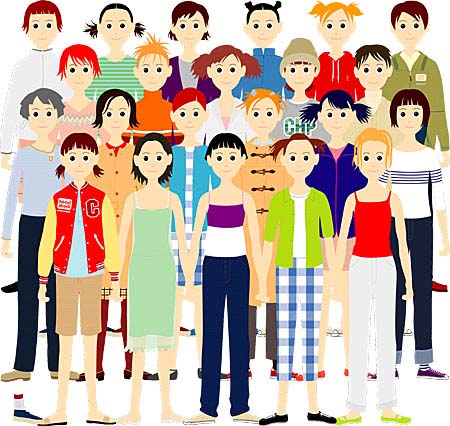Superflat
dal 14/7/2001 al 14/10/2001
Segnalato da
Chiho Aoshima
Enlightenment (Hiro Sugiyama)
Henmaru Machino
Mr.
Shigeyoshi Ohi
Sleep
Hitoshi Tomizawa
Bome
Yoshinori Kanada
Takashi Murakami
Groovisions
Koji Morimoto
Katsushige Nakahashi
Masafumi Sanai
Chikashi Suzuki
Yoshitomo Nara
Aya Takano
Kentaro Takekuma
20471120
Takashi Murakami
14/7/2001
Superflat
Walker Art Center, Minneapolis
Organized by Tokyo-based artist Takashi Murakami, the exhibition Superflat investigates a tendency toward two-dimensionality in Japanese visual art, animation, graphic design, and fashion. Tracing this flatness back to pioneers of Japanese painting in the 17th, 18th, and 19th centuries, Murakami has developed a theory of super-flat Japanese art in which this legacy can be seen to be resurrected in the post-World War II rise of the Japanese cartoon cultures of manga (comic books) and anime (animation).

Organized by Tokyo-based artist Takashi Murakami, the exhibition Superflat investigates a tendency toward two-dimensionality in Japanese visual art, animation, graphic design, and fashion. Tracing this flatness back to pioneers of Japanese painting in the 17th, 18th, and 19th centuries, Murakami has developed a theory of super-flat Japanese art in which this legacy can be seen to be resurrected in the post-World War II rise of the Japanese cartoon cultures of manga (comic books) and anime (animation).
In his essay A Theory of Super Flat Japanese Art (2000),
Murakami suggests a direct line of historical descent
between the flatness of the prints of the 19th-century
master Katsushika Hokusai, for example, and the 1970s
television animation of Yoshinori Kanada. Both share a
uniquely Japanese sense of superflatness, which because it
is decidedly unlike our normal reality, Murakami argues, can
create an escape from the pressures and expectations of
everyday life.
Superflat presents works by 19 of the most exciting artists
working in Japan today in painting, photography, works on
paper, video, fashion, computer animation, cartoons,
performance, and sculpture. While all of these artists lend
support to Murakami's argument about two-dimensionality,
each also explores and exceeds the limits of their
respective genres. For example, Koji Morimoto, best known
for designing the opening credits for MTV Japan, makes
sketches and animations that take their inspiration from
17th-century Japanese scrolls and statues. Likewise, the
styled photographs of Masafumi Sanai and Chikashi Suzuki
deal with prevalent cultural subjects while imitating the look
of fashion and commercial photography.
Fashion itself plays a significant part in Japanese culture,
and many artists are working within the everyday reality of
ready-to-wear clothing. A performance group as well as a
clothing line, 20471120 stages elaborate large-scale fashion
shows that invite audience participation. The brand's
mantra is fashion, art, and character. The graphic design
firm groovisions, on the other hand, has created a persona
called Chappie that appears many places, often multiple
times in the same instance, wearing different outfits. The
Chappie boys and girls are distinguishable only by the
clothing they wear, making a poignant statement about the
place of fashion in our lives. Cute, cartoonlike images,
known in Japanese as kawaii, are a predominant part of
contemporary commercial culture. In Yoshitomo Nara's
cartoonishly aggressive punk children, Chiho Aoshima's
digitally rendered girls, or Kentaro Takekuma's familiar
cartoon image of Thomas the Tank Engine (a project that
aims to deter suicidal commuters from jumping in front of
trains), Japan's consumer culture of cuteness is analyzed
and dismantled through a variety of provocative strategies.
In Murakami's argument, all of this work can be traced back
visually through the techniques of anime to a wide range of
premodern Japanese master painters. It is this legacy of
the superflat that lives on today in the cultural DNA of
contemporary Japanese art and visual culture at large.
Artists:
Chiho Aoshima
Enlightenment (Hiro Sugiyama)
Henmaru Machino
Mr.
Shigeyoshi Ohi
Sleep
Hitoshi Tomizawa
Bome
Yoshinori Kanada
Takashi Murakami
Groovisions
Koji Morimoto
Katsushige Nakahashi
Masafumi Sanai
Chikashi Suzuki
Yoshitomo Nara
Aya Takano
Kentaro Takekuma
20471120
SUPERFLAT WAS ORGANIZED BY TAKASHI MURAKAMI FOR THE MUSEUM OF CONTEMPORARY ART, LOS ANGELES
Gallery Hours
Open Tuesday, Wednesday, Friday, and Saturday, 10 am-5 pm; Thursday, 10 am-9 pm; Sunday, 11 am-5 pm; Closed Monday.



